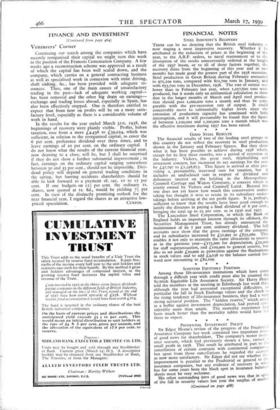TEXTILE TRADE REVIVAL
In the past two years the Lancashire cotton trade has had more than its normal quota of fluctuations. In the early months of 1937 demand was remarkably good, but there followed a slackening which last year developed into a full-sized depres- sion. Now, once again, orders are beginning to come in, and the industry itself is trying to get prices back on to a decent footing. In the past three weeks, for example, quota- tions for American yarns have been raised by over id. per pound, and, if all goes well, undertakings such as the Lanca- shire Cotton Corporation will soon be making profits on the grand scale. The time has therefore arrived, I think, when one might usefully consider Lancashire Cotton prefer- ence and ordinaries whose merits as lock-up investments have often stressed in these notes.
The Corporation's financial year runs to October 31, so that the first half-year is just ending. I imagine that trading conditions have been very unfavourable during this period. but I also feel that between April and November the going should be good. Good enough, in any event, to ensure the payment of the 5 per cent. preference dividend with a fair margin to spare. From the preference standpoint it is worth remembering that certain moves were made in stock-values at the end of last October, which provided for the sale of certain stocks, should this be found necessary or desirable, at prices which may be even lower than stock values. The Corporation thus began the current year with something in hand. The iz preferences, at 16s. 6d., yield just over 6 per cent., and are worth holding as an investment. The% also have the speculative attraction of a conversion ngl.' into the ordinaries at par which, although not of any valu.-- just yet, may be valuable later on. At 1 is 9d. the L. ordinaries are a good recovery speculation.
(Continued on page 466)
FINANCE AND INVESTMENT
(Continued from page 464)
Venturers' Corner
Continuing our search among the companies which have recently reorganised their capital we might turn this week to the position of the Francois Cementation Company. A few weeks ago a reconstruction scheme was approved as a result of which the capital has been well scaled down, and the company, which carries on a general contracting business as well as specialised work in connexion with mine driving, shaft sinking, &c., has been provided with adequate re- sources. Thus, one of the main causes of unsatisfactory trading in the past—lack of adequate working capital— has been removed and the other big drain on earnings— exchange and trading losses abroad, especially in Spain, has also been effectively stopped. One is therefore entitled to expect that from now on profits will be on a more satis- factory level, especially as there is a considerable volume of work in hand.
In the results for the year ended March 31st, 1938, the beginnings of recovery were plainly visible. Profits, before taxation, rose from a mere £4,438 to £39,024, which was sufficient, in relation to the reorganised capital, to cover the 6 per cent. preference dividend over three times, and to leave earnings of zo per cent. on the ordinary capital. I do not know what the results of the current financial year, now drawing to a close, will be, but I shall be surprised if they do not show a further substantial improvement ; in fact, earnings on the ordinary capital ranging somewhere between 3o and 35 per cent., should not be impossible. Divi- dend policy will depend on general trading conditions in the spring, but barring accidents shareholders should be able to look forward to a payment of, say, 10 to 15 per cent. If one budgets on 121 per cent. the ordinary is. shares, now quoted at is. 8d., would be yielding 71 per cent. In view of the distinctly promising outlook for the next financial year, I regard the shares as an attractive low-











































 Previous page
Previous page